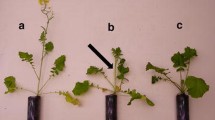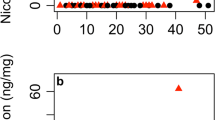Abstract
Although the effect of herbivory on plant reproduction has been investigated in some detail, little is known about how herbivores affect floral signalling. Here, we investigated the effect of foliar herbivory by the African Cotton Leafworm (Spodoptera littoralis) on floral signalling and fruit set in the White Campion (Silene latifolia). We found no effects of herbivory on floral traits involved in visual signalling (flower number, corolla diameter, calyx length, petal length) or in amount of nectar produced. However, Spodoptera-infested plants emitted higher amounts of the two floral volatiles, (Z)-3-hexenyl acetate and β-ocimene, than control plants. Open pollinated, infested plants also were found to produce more fruits than control plants, but only with nocturnal pollinators. Experimental addition of the two induced floral volatiles to non-infested Silene flowers also led to the production of more fruits with nocturnal pollination. This suggests that higher fruit production in herbivore-infested plants was caused by increased nocturnal pollinator attraction, mediated by the induced floral emission of these two volatiles. Our results show that the effects of herbivory on plant reproductive success are not necessarily detrimental, as plants can compensate herbivory with increased investment in pollinator attraction.



Similar content being viewed by others
References
Abdala-Roberts L, Parra-Tabla V, Navarro J (2007) Is floral longevity influenced by reproductive costs and pollination success in Cohniella ascendens (Orchidaceae)? Ann Bot 100:1367–1371
Abel C, Clauss M, Schaub A, Gershenzon J, Tholl D (2009) Floral and insect-induced volatile formation in Arabidopsis lyrata ssp. petraea, a perennial, outcrossing relative of A. thaliana. Planta 230:1–11
Adler LS, Wink M, Distl M, Lentz AJ (2006) Leaf herbivory and nutrients increase nectar alkaloids. Ecol Lett 9:960–967
Agrawal AA (2011a) Current trends in the evolutionary ecology of plant defence. Funct Ecol 25:420–432
Agrawal AA (2011b) New synthesis-trade-offs in chemical ecology. J Chem Ecol 37:230–231
Barber NA, Adler LS, Theis N, Hazzard RV, Kiers ET (2012) Herbivory reduces plant interactions with above- and belowground antagonists and mutualists. Ecology 93:1560–1570
Belsky AJ (1986) Does herbivory benefit plants? A review of the evidence. Am Nat 127:870–892
Bergelson J, Crawley MJ (1992) Herbivory and Ipomopsis aggregata: the disadvantages of being eaten. Am Nat 139:870–882
Bergelson J, Juenger T, Crawley MJ (1996) Regrowth following herbivory in Ipomopsis aggregata: compensation but not overcompensation. Am Nat 148:744–755
Bruinsma M, Lucas-Barbosa D, ten Broeke CJ, van Dam NM, van Beek TA, Dicke M, van Loon JJ (2014) Folivory affects composition of nectar, floral odor and modifies pollinator behavior. J Chem Ecol 40:39–49
Brys R, Shefferson RP, Jacquemyn H (2011) Impact of herbivory on flowering behaviour and life history trade-offs in a polycarpic herb: a 10-year experiment. Oecologia 166:293–303
CABI/EPPO (1997) Quarantine pests for Europe, 2nd edn. CAB International, Wallingford
Campbell SA, Kessler A (2013) Plant mating system transitions drive the macroevolution of defense strategies. Proc Natl Acad Sci U S A 110(10):3973–3978
Dicke M, Van Beek TA, Posthumus MA, Dom NB, Van Bokhoven H, De Groot AE (1990) Isolation and identification of volatile kairomone that affects acarine predator–prey interactions. Involvement of host plant in its production. J Chem Ecol 16:381–396
Dötterl S, Jürgens A, Seifert K, Laube T, Weissbecker B, Schutz S (2006) Nursery by a moth in Silene latifolia: the role of odours in eliciting antennal and behavioural responses. New Phytol 169:707–718
Dufaÿ M, Anstett MC (2003) Conflicts between plants and pollinators that reproduce within inflorescences: evolutionary variations on a theme. Oikos 100:3–14
Elmqvist T, Gardfjell H (1988) Differences in response to defoliation between males and females of Silene dioica. Oecologia 77:225–230
El-Sayed AM, Suckling DM, Byers JA, Jang EB, Wearing CH (2009) Potential of “lure and kill” in long-term pest management and eradication of invasive species. J Econ Entomol 102:815–835
Elzinga JA, Biere A, Harvey JA (2002) The rearing of the gregarious koinobiont endoparasitoid Microplitis tristis (Hymenoptera: Braconidae) on its natural host Hadena bicruris (Lepidoptera: Noctuidae). Proc Exp Appl Entomol 13:109–115
Freeman RS, Brody AK, Neefus CD (2003) Flowering phenology and compensation for herbivory in Ipomopsis aggregata. Oecologia 136:394–401
Jürgens A, Witt T, Gottsberger G (1996) Reproduction and pollination in central European populations of Silene and Saponaria species. Bot Acta 109:316–324
Kessler A, Baldwin IT (2001) Defensive function of herbivore-induced plant volatile emissions in nature. Science 291:2141–2144
Kessler A, Halitschke R (2009) Testing the potential for conflicting selection on floral chemical traits by pollinators and herbivores: predictions and case study. Funct Ecol 23:901–912
Kessler A, Halitschke R, Poveda K (2011) Herbivory-mediated pollinator limitation: negative impacts of induced volatiles on plant-pollinator interactions. Ecology 92:1769–1780
Lehtila K, Strauss SY (1997) Leaf damage by herbivores affects attractiveness to pollinators in wild radish, Raphanus raphanistrum. Oecologia 111:396–403
Lloyd DG (1980) Sexual strategies in plants 1. A hypothesis of serial adjustment of maternal investment during 1 reproductive session. New Phytol 86:69–80
Lohman DJ, Zangerl AR, Berenbaum MR (1996) Impact of floral herbivory by parsnip webworm (Oecophoridae: Depressaria pastinacella Duponchel) on pollination and fitness of wild parsnip (Apiaceae, Pastinaca sativa L.). Am Midl Nat 136:407–412
Lucas-Barbosa D, van Loon JJA, Gols R, van Beek TA, Dicke M (2013) Reproductive escape: annual plant responds to butterfly eggs by accelerating seed production. Funct Ecol 27:245–254
Marquis RJ (1992) The selective impact of herbivores. In: Fritz RS, Simms EL (eds) Plant resistance to herbivores and pathogens: ecology, evolution and genetics. University of Chicago Press, Illinois, pp 301–325
Pareja M, Qvarfordt E, Webster B, Mayon P, Pickett J, Birkett M, Glinwood R (2012) Herbivory by a phloem-feeding insect inhibits floral volatile production. PLoS ONE 7, e31971. doi:10.1371/journal.pone.0031971
Pichersky E, Gershenzon J (2002) The formation and function of plant volatiles: perfumes for pollinator attraction and defense. Curr Opin Plant Biol 5:237–243
Poveda K, Steffan-Dewenter I, Scheu S, Tscharntke T (2003) Effects of below- and above-ground herbivores on plant growth, flower visitation and seed set. Oecologia 135:601–605
Poveda K, Steffan-Dewenter I, Scheu S, Tscharntke T (2005) Floral trait expression and plant fitness in response to below- and aboveground plant-animal interactions. Perspect Plant Ecol Evol Syst 7:77–83
Raguso RA (2008) Wake up and smell the roses: the ecology and evolution of floral scent. Annu Rev Ecol Evol Syst 39:549–569
Reekie E, Bazzaz F (2005) Reproductive allocation in plants. Elsevier Academic Press, San Diego
Reichman OJ, Smith SC (1991) Responses to simulated leaf and root herbivory by biennial, Tragopogon dubius. Ecology 72:116–124
Schiestl FP (2010) The evolution of floral scent and insect chemical communication. Ecol Lett 13:1643–1656
Schiestl FP, Kirk H, Bigler L, Cozzolino S, Desurmont G (2014) Herbivory and floral signalling: phenotypic plasticity and trade-offs between reproduction and indirect defence. New Phytol 203:257–266
Seybold S (1990) Caryophyllaceae. In: Sebald O, Seybold S, Philippi G (eds) Die Farn- und Blütenpflanzen Baden-Württembergs. Band 1. Verlag Eugen Ulmer, Stuttgart, pp 368–466
Strauss SY, Conner JK, Rush SL (1996) Foliar herbivory affects floral characters and plant attractiveness to pollinators: implications for male and female plant fitness. Am Nat 147:1098–1107
Strauss SY, Rudgers JA, Lau JA, Irwin RE (2002) Direct and ecological costs of resistance to herbivory. Trends Ecol Evol 17:278–285
Young HJ (2002) Diurnal and nocturnal pollination of Silene alba (Caryophyllaceae). Am J Bot 89:433–440
Wolfe LM, Elzinga JA, Biere A (2004) Increased susceptibility to enemies following introduction in the invasive plant Silene latifolia. Ecol Lett 7:813–820
Zangerl AR, Berenbaum MR (2009) Effects of florivory on floral volatile emissions and pollination success in the wild parsnip. Arthropod Plant Int 3:181–191
Acknowledgments
The authors thank Anna Salatiello and Giovanna Dati for help with conducting experiments. David Carrasco from Swedish University of Agricultural Science provided the Spodoptera larvae used in this study. This research was funded by the CRN-InvaVol grant and POR-Campania BIP to SC and SF and by Swiss National Science Funds (SNF/ESF grant no. 31VL30_134416 to FPS, embedded in the Eurocores Invavol program).
Author information
Authors and Affiliations
Corresponding author
Electronic supplementary material
Below is the link to the electronic supplementary material.
Online Resource 1
(DOCX 12 kb)
Online Resource 2
(DOCX 14 kb)
Online Resource 3
(DOCX 238 kb)
Rights and permissions
About this article
Cite this article
Cozzolino, S., Fineschi, S., Litto, M. et al. Herbivory Increases Fruit Set in Silene latifolia: A Consequence of Induced Pollinator-Attracting Floral Volatiles?. J Chem Ecol 41, 622–630 (2015). https://doi.org/10.1007/s10886-015-0597-3
Received:
Revised:
Accepted:
Published:
Issue Date:
DOI: https://doi.org/10.1007/s10886-015-0597-3




